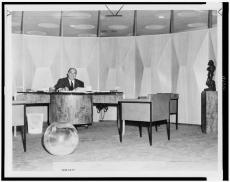It's hard to imagine the National Museum of American History, entrenched as it is on the National Mall, situated anywhere else in Washington, DC. However, did you know that the museum could have been located in Southwest Washington? While researching the museum's early history, I stumbled upon this anecdote in former Museum of History and Technology (now known as the National Museum of American History) director Frank A. Taylor’s oral history interviews. Mid-century real estate mogul William Zeckendorf, through his company Webb and Knapp, set his sights on redeveloping Southwest Washington in the early 1950s. Webb and Knapp encouraged the federal government to build there, as they believed a government investment in the area would ease their own economic burden. The government would pay for the infrastructure of road, water, power, sewer lines, and other utilities. Around this time, the Smithsonian Institution was trying to get legislation passed to create the future National Museum of American History. Webb and Knapp learned about this legislation, which placed the museum at its current Constitution Avenue site, and tried to move it to Southwest Washington.
Mid-century real estate mogul William Zeckendorf, through his company Webb and Knapp, set his sights on redeveloping Southwest Washington in the early 1950s. Webb and Knapp encouraged the federal government to build there, as they believed a government investment in the area would ease their own economic burden. The government would pay for the infrastructure of road, water, power, sewer lines, and other utilities. Around this time, the Smithsonian Institution was trying to get legislation passed to create the future National Museum of American History. Webb and Knapp learned about this legislation, which placed the museum at its current Constitution Avenue site, and tried to move it to Southwest Washington.
In his interview, Taylor revealed that then-Smithsonian Secretary Leonard Carmichael wished to compromise, believing that a new Smithsonian museum established in Southwest Washington was better than no new museum at all. Assistant Secretaries John L. Keddy and John E. Graf disagreed with Carmichael, creating tension amongst the staff. Frank Taylor also argued in favor of the Mall location, stating in his oral history interview that he felt "if we were going to serve the public, this is where we ought to be." At the time, all of the Smithsonian Institution buildings - the Freer Gallery of Art, the National Museum of Natural History, the Arts and Industries Building, and the Smithsonian Castle - were located on the Mall. According to Taylor's interviews, staff worried that a museum located in Southwest Washington would have lost a lot of traffic generated by those museums, the National Gallery of Art, Capitol Hill, and the nearby monuments.
Webb and Knapp had some powerful allies in Congress. Congressman James C. Auchincloss, prominent member of the House Public Works Committee responsible for the museum's future, pushed for the Southwest Washington location. While the amended bill giving the National Capital Planning Commission control over the museum's location was brought forth in 1954, Auchincloss' sole objection defeated this bill, as he wanted an explicitly stated Southwest Washington location for the museum. Ultimately, this was the best decision for advocates of the Mall location, as the National Capital Planning Commission could have been pressured to put the new museum in Southwest Washington. A new bill authorizing the creation and construction of the Museum of History and Technology was passed in 1957, again specifying its Constitution Avenue location. We do not know why Auchincloss did not object to that plan, as Webb and Knapp still had a presence in Southwest Washington. Taylor speculated that Zeckendorf's declining fortunes led to decreased influence in Congress. The museum later opened in January 1964.
Had Zeckendorf's Plan succeeded, it would have had a significant impact on the Smithsonian's future development. As Taylor remarked, "I'm not sure that we had any great dedication to a master plan, but it probably did influence the future decisions as to where to put the Air and Space Museum and the Hirshhorn [Museum and Sculpture Garden]." We can only guess how a Southwest location would have changed the National Museum of American History, but it would have permanently altered the National Mall's cultural landscape.
Related Resources
Related Collections

 Mid-century real estate mogul William Zeckendorf, through his company Webb and Knapp, set his sights on redeveloping Southwest Washington in the early 1950s. Webb and Knapp encouraged the federal government to build there, as they believed a government investment in the area would ease their own economic burden. The government would pay for the infrastructure of road, water, power, sewer lines, and other utilities. Around this time, the Smithsonian Institution was trying to get legislation passed to create the future National Museum of American History. Webb and Knapp learned about this legislation, which placed the museum at its current Constitution Avenue site, and tried to move it to Southwest Washington.
Mid-century real estate mogul William Zeckendorf, through his company Webb and Knapp, set his sights on redeveloping Southwest Washington in the early 1950s. Webb and Knapp encouraged the federal government to build there, as they believed a government investment in the area would ease their own economic burden. The government would pay for the infrastructure of road, water, power, sewer lines, and other utilities. Around this time, the Smithsonian Institution was trying to get legislation passed to create the future National Museum of American History. Webb and Knapp learned about this legislation, which placed the museum at its current Constitution Avenue site, and tried to move it to Southwest Washington.


Leave a Comment